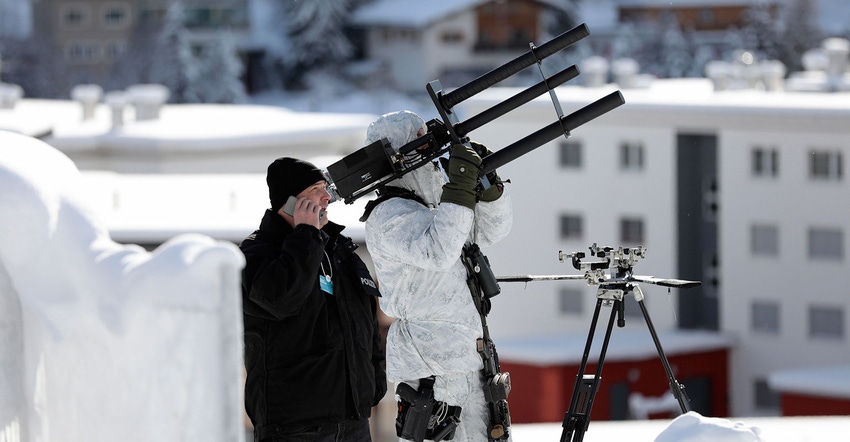European authorities worry that drones could be used for nefarious purposes.
January 18, 2017

The gunner looks like a character in a dystopian movie in which the ruling elite prepare to fight off a scrappy, tech-savvy rebellion. The reality? Maybe not that far off.
Swiss police were pictured this week in Davos testing anti-drone jammers, which resemble massive machine guns, as part of security preparations for the World Economic Forum. The annual gathering of members of the world's business and political elite has brought more than 3,000 attendees to the skiing resort.
In Davos, police were testing to make sure the equipment was ready and able to take down any drones potentially carrying out covert missions, said Steffen Wicker, managing director at H.P. Marketing & Consulting Wüst, which makes the jamming guns pictured.
The concern is that drones could be used to take pictures and map police and security positions, conduct surveillance, or, in a worst-case scenario, launch an attack.
The German company has sold various types of jamming equipment to police and military forces around the world for almost 30 years. Demand for drone-specific devices has risen as the flying machines have become cheaper and more prevalent, Wicker said.
While the market for commercial applications of drone technology is estimated at $2 billion, it could be worth $127 billion by 2020, according to consulting firm PricewaterhouseCoopers. Michal Mazur, a partner in PwC's drone division, said it was too early to estimate the size of the counter-drone market.
“In the past, our main customers were in the Middle East,” Wicker said in a phone interview. Customers used the jammers to guard against terrorist attacks, he said.
The specific model in operation at Davos, the HP 47 Counter UAV Jammer, specializes in blocking signals from drones more than 1,000 feet away. The HP 47 was used last year by German police in Berlin during President Barack Obama's visit, as well as during a security conference in Hamburg in December, Wicker said.
Despite the resemblance to guns, jammers don't literally shoot the drones.
The HP 47 interferes with a drone by blocking it from sending signals back to its operator and disabling remote-control access. The drone wouldn't be able to transmit its video feed, either.
The drone wouldn't just drop to the ground. Instead, it should hover in place within an invisible fence created by the jammer.
At that point, snipers could target the drone, or security officials could launch a rocket-propelled net to capture it. OpenWorks, a British startup, has developed a device that uses a parachute to float a captured drone to the ground.
WEF spokesman Georg Schmitt said drones could threaten air traffic and safety, and this wasn't the first year anti-drone security measures have been used. He declined to confirm the manufacturer of the drone gun pictured.
“While drones have great potential, they have—just as every new technology or aspect of the Fourth Industrial Revolution—also a potential downside,” Schmitt said. “The forum takes the safety and security of its participants seriously. It is therefore normal that we take any potential issue into account and prepare for it.”
—With assistance from Alaa Shahine.
About the Author(s)
You May Also Like
.jpeg?width=700&auto=webp&quality=80&disable=upscale)
.png?width=700&auto=webp&quality=80&disable=upscale)



.png?width=300&auto=webp&quality=80&disable=upscale)
